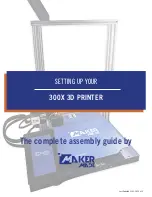
This isn't an exhaustive list but it does include the big hitters and, as you can see, there
are a few of them so it is very important to take a methodical (#2 and #8) and documented (#7)
approach when solving bed-related problems. This is also a place where careful observation
(#6) can play an important part.
I'm not going to go through all of these in detail now but did want to comment about the
last one - cleanliness. Whatever you do, make sure everything near and on your printer is clean
and grease free. Silicone greases and lubricants are especially problematic since they are
invisible and very difficult to remove. Keep them away from your machine.
Your fingers are a prime source of contaminants. Every time you touch the filament or
bed, you risk leaving a greasy print (see my observation in #6) and these can (and will) cause
issues. I try not to handle filament with my bare fingers, I use cotton gloves. If you use a plastic
or rubber glove, make sure it isn't coated or powdered - we're trying to eliminate sources of
contamination, not introduce them. On the occasions that I do handle filament with my bare
hands I wash and dry them thoroughly first. This is one area that I think affects a lot of user's
and is completely overlooked. How many times have you loaded filament right after eating
chips? It introduces a big variable that can be difficult to track down, so develop good habits and
eliminate contamination as a variable.
Your fingers can also leave contaminants on the bed when you remove a part or brush
off stray filament strands. Don't touch the bed surface if at all possible. If you do, clean/degrease
it with an appropriate cleaner. For uncoated surfaces like borosilicate glass, PEI, the various 3d
party surfaces (PrintInZ and BuildTak), and films (window tint, Kapton) you can use isopropyl
alcohol. I like to use the little packages of wipes as they are convenient and safe. You can also
do a quick wipe of your fingers before tossing it in the trash. It is more difficult to deal with
coatings like PVA glue, glue stick, and hairspray since these can't be cleaned. If you suspect a
contaminated coating, your only recourse is to remove and reapply it.
Finally, don't overlook filament storage, keep it clean too. I store mine in large zip lock bags to
keep off dust. You can put packets of desiccant to help remove moisture in the bag too.
#11 Learn to Diagnose.
Patient: "Dr. it hurts when I move my arm like this."
Dr.: "Then don't move your arm like that!"
The first point of this joke is, many people do the same thing over and over again without
making any changes or stopping to think about what to change (see #8: remember, change one
thing at a time) - as if just repeating the same print with the same parameters will magically
solve the problem. It won't (see my footnote below).
The second point of the joke is that the Dr. didn't attempt to actually determine why the
patient's arm hurt, he just had him avoid the problem. I see that a lot too. Usually it takes to form
of "I tried printing it with my red PLA and it failed but everything was fine with my blue PLA".
100





































